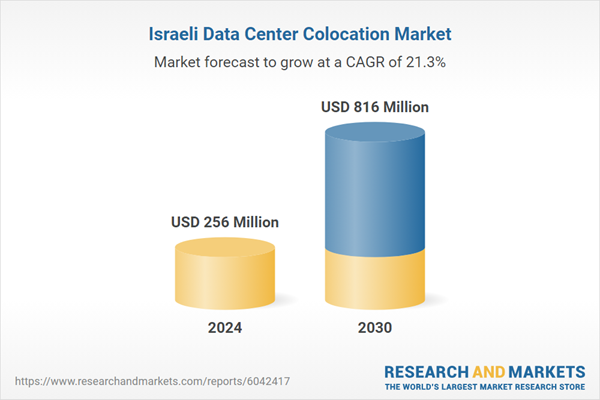Speak directly to the analyst to clarify any post sales queries you may have.
In 2024, wholesale colocation in Israel accounted for a market share of around 21%, whereas retail colocation accounted for the remaining 78%. By 2030, this trend is projected to reverse. Retail colocation market share is estimated to decline, whereas wholesale colocation is slated to rise, driven by cloud adoption and hyperscale demand.
The Israel data center colocation market is among the major colocation data center hubs, which consists of 32 operational colocation data center facilities as of December 2024. In terms of area, Tel Aviv and Petah Tikva are the prominent locations for data center investments. Jerusalem, Rosh Haayin, Tirat Carmel, and Raanana are the emerging locations that attract data center development initiatives.
WHAT'S INCLUDED?
- Transparent research methodology and insights on the industry's colocation of demand and supply.
- The market size is available in terms of utilized white floor area, IT power capacity, and racks.
- The market size available in terms of Core & Shell Vs Installed Vs Utilized IT Power Capacity, along with the occupancy %.
- The study of the existing Israel data center industry landscape and insightful predictions about industry size during the forecast period.
- An analysis of the current and future colocation demand in Israel by several industries.
- The impact of AI on the data center industry in the Israeli industry.
- Study on the sustainability status in the country
- Analysis of current and future cloud operations in the country.
- Snapshot of upcoming submarine cables and existing cloud-on-ramps services in the country.
- Snapshot of existing and upcoming third-party data center facilities in Israel
- Facilities Covered (Existing): 32
- Facilities Identified (Upcoming): 27
- Coverage: 13+ Cities
- Existing vs. Upcoming (White Floor Area)
- Existing vs. Upcoming (IT Load Capacity)
- Data Center Colocation Market in Israel
- Colocation Market Revenue & Forecast (2024-2030)
- Retail Colocation Revenue (2024-2030)
- Wholesale Colocation Revenue (2024-2030)
- Retail Colocation Pricing along with Addons
- Wholesale Colocation Pricing, along with the pricing trends
- An analysis of the latest trends, potential opportunities, growth restraints, and prospects for the Israel data center colocation market.
- Competitive landscape, including industry share analysis by the colocation operators based on IT power capacity and revenue.
- The vendor landscape of each existing and upcoming colocation operator is based on the existing/ upcoming count of data centers, white floor area, IT power capacity, and data center location.
THE REPORT INCLUDES:
- Colocation Supply (MW, Area, Rack Capacity)
- Colocation Demand (MW, Area, Rack Capacity) and by End-User (Cloud/IT, BFSI, etc..)
- Colocation Revenue (Retail & Wholesale Colocation Services)
- Competitive Scenario (Share Analysis by Revenue & MW Capacity)
VENDOR LANDSCAPE
Existing Colocation Operators
1. Bynet Data Communications2. EdgeConneX
3. MedOne
4. SDS Data Center
5. Bezeq International
6. Compass Datacenters
7. Global Technical Realty
8. Serverfarm
9. Other Operators
New Operators
- Anan
- Ned Data Centers
- Kardan Israel and Geva Real Estate (multiDC)
- Keystone
- Mega Data Centers
- Serverz Data Center
- Techtonic
KEY QUESTIONS ANSWERED:
1. What is the count of existing and upcoming colocation data center facilities in Israel?2. How much MW of IT power capacity is likely to be utilized in Israel by 2030?
3. What factors are driving the Israel data center colocation market?
4. Who are the new entrants in the Israeli data center industry?
Table of Contents
Companies Mentioned
- Bynet Data Communications
- EdgeConneX
- MedOne
- SDS Data Center
- Bezeq International
- Compass Datacenters
- Global Technical Realty
- Serverfarm
- Anan
- Ned Data Centers
- Kardan Israel and Geva Real Estate (multiDC)
- Keystone
- Mega Data Centers
- Serverz Data Center
- Techtonic
Methodology
Our research comprises a mix of primary and secondary research. The secondary research sources that are typically referred to include, but are not limited to, company websites, annual reports, financial reports, company pipeline charts, broker reports, investor presentations and SEC filings, journals and conferences, internal proprietary databases, news articles, press releases, and webcasts specific to the companies operating in any given market.
Primary research involves email interactions with the industry participants across major geographies. The participants who typically take part in such a process include, but are not limited to, CEOs, VPs, business development managers, market intelligence managers, and national sales managers. We primarily rely on internal research work and internal databases that we have populated over the years. We cross-verify our secondary research findings with the primary respondents participating in the study.

LOADING...
Table Information
| Report Attribute | Details |
|---|---|
| No. of Pages | 57 |
| Published | October 2025 |
| Forecast Period | 2024 - 2030 |
| Estimated Market Value ( USD | $ 256 Million |
| Forecasted Market Value ( USD | $ 816 Million |
| Compound Annual Growth Rate | 21.3% |
| Regions Covered | Israel |
| No. of Companies Mentioned | 15 |









